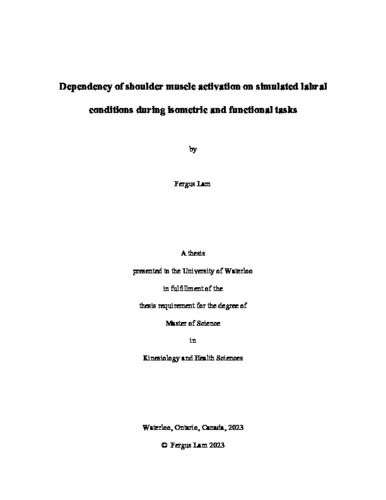| dc.contributor.author | Lam, Fergus | |
| dc.date.accessioned | 2023-08-14 14:24:08 (GMT) | |
| dc.date.available | 2023-08-14 14:24:08 (GMT) | |
| dc.date.issued | 2023-08-14 | |
| dc.date.submitted | 2023-08-03 | |
| dc.identifier.uri | http://hdl.handle.net/10012/19683 | |
| dc.description.abstract | Glenohumeral (GH) joint stability depends on a combination of shoulder muscular action and the glenoid labrum. Labral injuries and degenerations can affect glenohumeral joint reaction forces and potentially modify shoulder muscular efforts. However, the relationship between shoulder labral condition and muscle demands lacked clarity as compensatory muscle strategies accompanying labral compromise were unidentified. Targeted analysis was required to determine each muscle’s activation, as traditional non-invasive biomechanical physical measurements could not readily assess the influence of labral damage. This study aimed to determine how simulated labral statuses influenced shoulder muscle activations using a customized mathematical biomechanical shoulder model. Secondarily, this study investigated potential links between observed variations in muscle recruitment and potential muscle overuse. Six isometric and six functional movement tasks kinematic data were collected using a passive 3D motion capture system to generate necessary geometric inputs for the musculoskeletal model from a single male participant. A total of 13 labral conditions were simulated for each isometric and functional movement task by altering the glenoid stability constraints within an existing computational shoulder model. The percentage of maximal predicted muscle group capability (%MMGC) of the rotator cuff (RC) muscles and glenohumeral articulating (GA) muscles and glenohumeral joint contact forces were predicted by the shoulder model to illustrate the potential responses from the shoulder (i.e., changes in muscle demand and the relationship of joint contact-shear force) to changes in the stability of the GH joint between simulated conditions. Task performance and potential for muscle fatigue were ranked and evaluated by comparing the changes in muscle group recruitment, the percentage changes in %MMGC and glenohumeral shear forces, and the directional changes in glenohumeral shear forces among simulated labral conditions. RC muscles showed a substantial increase in muscular activation level of 5%–41% in activities when engaging in more physically demanding tasks, such as isometric external rotation, isometric abduction and weight relief lifting, compared to the intact condition. These large increases particularly occurred in simulated conditions with no labrum and a degenerated labrum in older age groups (ages over 60). This illustrated the aging impacts on GH joint stability and muscle recruitment strategies. Further, the high RC muscle activity contributed to a decrease in joint shear forces by further stabilizing the GH joint through the compression mechanism which is consistent with reduced humeral translation. Simulated surgical repairs effectively lowered the activation level of muscle groups, and the level of muscle activation was further decreased by surgical bone augmentations, such as posterior bone blocks, which further stabilized the GH joint. This study provided insight into the muscle strategies that may arise to compensate for directional shoulder instabilities. This information can be used as a guideline for secondary injury prevention by identifying connections between tissue overload during certain tasks and previously reported potential shoulder pathologies. In conclusion, this study can help raise awareness and inform considerations relative to compromised labral management and mechanistic bases for functional capacity. | en |
| dc.language.iso | en | en |
| dc.publisher | University of Waterloo | en |
| dc.subject | biomechanics | en |
| dc.subject | biomechanical model | en |
| dc.subject | glenoid labrum | en |
| dc.subject | muscle activation | en |
| dc.title | Dependency of shoulder muscle activation on simulated labral conditions during isometric and functional tasks | en |
| dc.type | Master Thesis | en |
| dc.pending | false | |
| uws-etd.degree.department | Kinesiology and Health Sciences | en |
| uws-etd.degree.discipline | Kinesiology | en |
| uws-etd.degree.grantor | University of Waterloo | en |
| uws-etd.degree | Master of Science | en |
| uws-etd.embargo.terms | 0 | en |
| uws.contributor.advisor | Dickerson, Clark | |
| uws.contributor.affiliation1 | Faculty of Health | en |
| uws.published.city | Waterloo | en |
| uws.published.country | Canada | en |
| uws.published.province | Ontario | en |
| uws.typeOfResource | Text | en |
| uws.peerReviewStatus | Unreviewed | en |
| uws.scholarLevel | Graduate | en |

